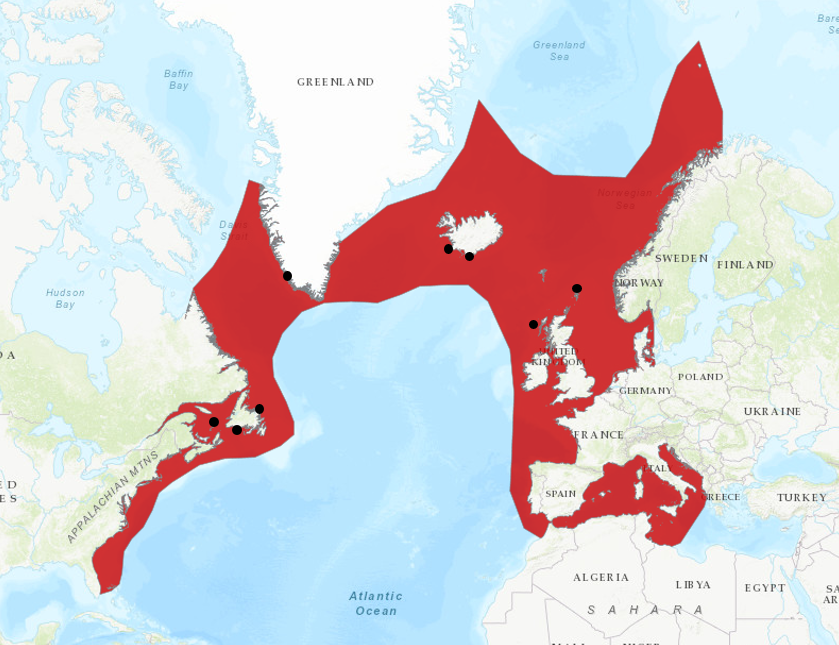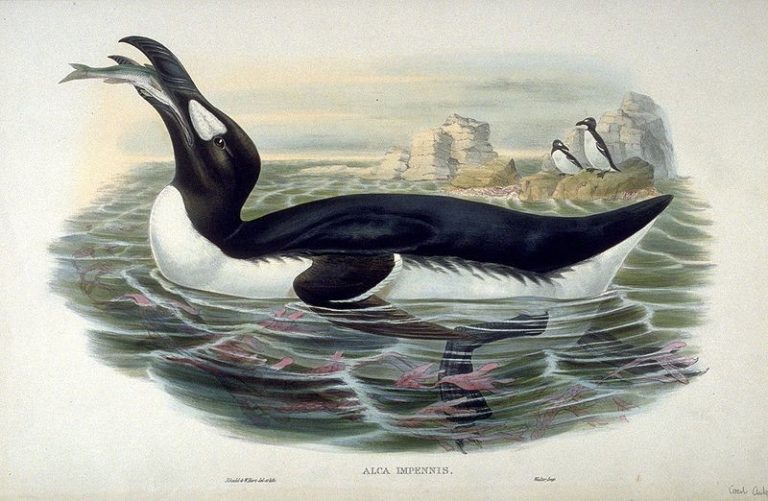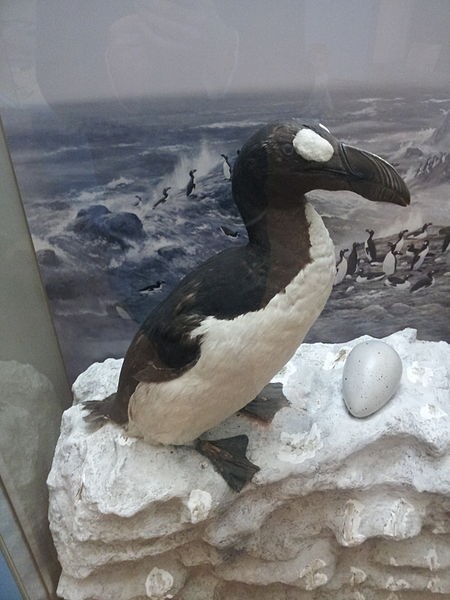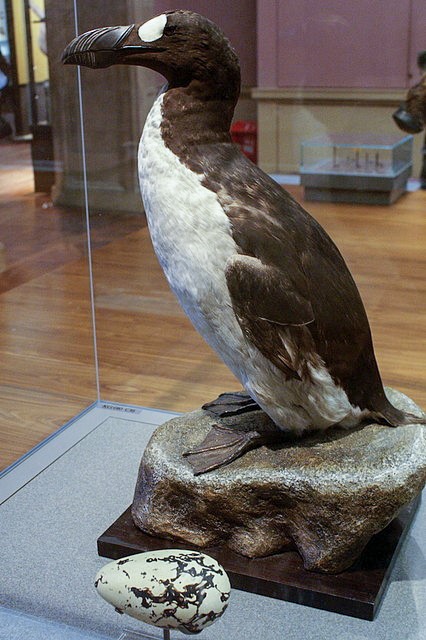Birdfinding.info ⇒ The last report of a Great Auk that is generally accepted as valid was a sighting from a fishing vessel on the Grand Banks east of Newfoundland in December 1852. The last specimens had been collected eight years earlier, reportedly a pair defending an egg (possibly the very last egg) at Eldey Rock, Iceland, on June 3, 1844. These final encounters marked the end of a centuries-long campaign in which the fishermen and explorers of several European nations collaborated in the annihilation of a recently abundant, but vulnerable species. As T. Parkin aptly remarked in 1894, “It never appears to have entered into the calculations of the earlier generations of Great Auks that, sooner or later, evolution would produce a race of sailors to whom no flat coasts would be impregnable.”
Great Auk †
Pinguinus impennis
Extinct. Formerly bred on North Atlantic islets and dispersed to adjacent waters.

Inferred historical distribution of the Great Auk with last known colony sites marked as black dots. © BirdLife International 2021
Breeding. Nested in large colonies from May to July. At least eight locations were active in historical times: three in Canada, one in Greenland, two in Iceland, and two on outlying European islands.
Funk Island, east of Newfoundland, supported ~10,000 pairs at the time of its discovery by modern Europeans, likely the majority of the world population at that time. Other confirmed Canadian colony sites were Penguin Island (named for the Great Auk) and Bird Rocks in the Gulf of St. Lawrence.
The Greenland site, Paamiut, was not confirmed with direct evidence of nesting, but the circumstantial evidence of a population in southwestern Greenland is strong and centers on Paamiut.
The last known nest was on Eldey, beside the southwestern coast of Iceland, in 1844. The local population had previously bred nearby on Geirfuglasker, but relocated after a volcanic eruption in 1830 submerged it. A second confirmed Icelandic colony site was in the Westmann Islands.
Although fossil evidence indicates that it likely bred prehistorically at numerous sites along European coasts from Norway to France—and possibly south to Spain and even east to Italy—the last two certain European colony sites were in the Faeroes and St. Kilda, Scotland.
Nonbreeding. Evidently wintered at sea in the latitudes of its breeding colonies and also much farther south—although, as a flightless bird, it was limited to swimmable distances. According to J. J. Audubon, it was seen regularly in winter along the coast of Massachusetts in the 1700s.
Great Auk bones have been recovered from middens (i.e., accumulated food scrap piles of prehistorical human populations) as far south as Florida and Gibraltar, and on Sicily and the southeastern coast of Italy (Otranto). These are generally interpreted as evidence of migration from more northerly breeding sites—although this remains conjectural, as the alternative explanations of local breeding populations and human transport cannot be ruled out.
Identification
The original “penguin” was an enormous, flightless version of its closest surviving relative, the Razorbill, sharing the same general body-plan, coloration, pattern, and long-but-tall, laterally compressed bill.

Great Auk eating a fish. (The Birds of Europe, vol. 5 pl. 55.) John Gould
It was about the size of a goose, 4 to 5 kg, and stood upright on land at 75-85 cm tall, with small vestigial wings.
Its remarkable bill measured approximately 82-90 mm long and 40-46 mm deep (i.e., tall), colored black, but with six or seven vertical whitish grooves on the outer half.

Great Auk. (No. 41, the “Hanover Auk”.) © Knoff
The upperparts were all-black except that breeding adults had a large white oval on the side of the forehead, between the eye and the bill. Nonbreeding adults more closely matched the Razorbill’s plumage pattern.
Notes
Monotypic species.
IUCN Red List Status: Extinct.
References
BirdLife International. 2021. Pinguinus impennis. The IUCN Red List of Threatened Species 2021: e.T22694856A205919631. https://dx.doi.org/10.2305/IUCN.UK.2021-3.RLTS.T22694856A205919631.en. (Accessed January 3, 2022.)
Gaston, A.J., and I.L. Jones. 1998. The Auks: Alcidae. Oxford University Press.
Hume, J.P. 2017. Extinct Birds (Second Edition). Bloomsbury Publishing PLC, London.
Meldgaard, M. 1988. The Great Auk, Pinguinus impennis (L.) in Greenland. Historical Biology 1:145-178.
